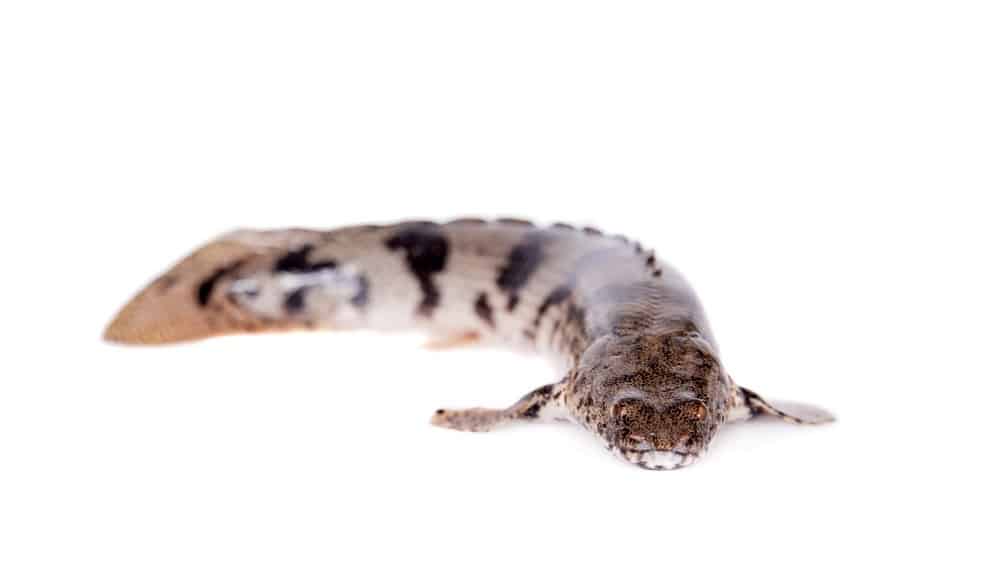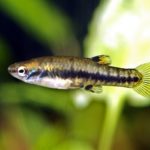Saddled bichirs (scientifically known as Polypterus endlicheri endlicheri) is a long, prehistoric-looking subspecies of the Polypterus genus. This species is an opportunistic ambush predator known for its unique hunting tactics and interesting behavioral features, such as its ability to breathe both in and out of water.

The saddled bichir is commonly found in marshy environments, rivers, and mangroves in Cameroon, Ghana, Sudan, Nigeria, Central African Republic, Burkina Faso, Mali, The Ivory Coast, and Benin. The species is known for its history, with saddled bichirs dating back to some 400 million years ago.
As the saddled bichir is so widely distributed in the wild and has a vast population figure, the demand in the aquarium trade doesn’t make a dent in the species’ conservation status.
Care Guide
Tank Size
The recommended minimum tank size is 90 gallons of water per saddled bichir. This is an active species that requires a nice amount of room to swim around in, as well as designated areas for them to hide underneath rocks or foliage. This amount of space should also give enough room for you to replicate the saddled bichir’s natural habitat.
Tank Mates
While the saddled bichir is a fairly laid-back fish, it’s not generally recommended giving the fish tank mates of other species. Saddled bichirs are carnivorous, which means that they can become territorial and aggressive to other fish.
It’s always a risky game trying to find the right tank mates for your saddled bichir – anything too small could get eaten, and anything the same size as the bichir could be picked on.
The ideal tank mates for a saddled bichir include:
- Clown loaches
- African knife
- Silver Dollar fish
- Oscars
- Flowerhorn cichlids
- Jack Dempsey fish
These species are bigger than saddled bichirs, which means they won’t be the targets of bullying (or potential eating). If you are to introduce tank mates to your bichir, make sure to provide an ample tank space for everyone to swim around. There must also be enough floor space for the food to be reached by the saddled bichir.
Same Species Tanks
It’s always nice to see more than one of the same fish in their tank, and fortunately, you can have more than one saddled bichir in the same tank! You just have to make sure to provide enough tank space for each fish – remember, the golden rule is to have 90 gallons of water for each fish.
If you are to have a same species tank of saddled bichir, we recommend raising them in the same tank from a juvenile age. This will prevent bullying in the future.
Water Parameters
Fortunately, saddled bichirs are hardy and adaptable fish when it comes to water parameters. Still, there are still some general guidelines to follow to provide the best environment for your fishy friends.
- Temperature: 74-82 °F
- Water hardness: Soft
- Acidity: 6.2-7.8 pH
- Carbonate hardness: 520 dKH
Regular water changes and monitoring the water will help to provide your saddled bichir with the healthiest, longest life possible. Even though they can breathe oxygen both in and out of water, it’s still required to maintain their water parameters.
What To Put In Their Tank
Saddled bichirs love a decorative tank that emulates their natural habitats. In the wild, these freshwater fish love to live in murky waters like mangroves and swamps, so feel free to fill the tank with driftwood, rocks, caves, and aquatic plants.
Not only will this make the fish feel at home, but it will also make the tank look visually appealing for viewers.
On the other hand, saddled bichirs also enjoy a lot of swimming space. This means that if you want to keep the tank sparse, they can adapt to that, too!
The main thing to worry about is picking the right substrate. Saddled bichirs are bottom-feeders, which means that they eat their food along the bottom of the tank.
Sand is the best surface for saddled bichirs, as gravel substrate can be rough on the fish’s belly. Gravel substrate can also accidentally be eaten by the bichir, which can lead to health problems.
Common Diseases
The saddled bichir is a hardy fish that doesn’t have any specific health problems related to the species (which is one of the reasons why they have such a long history!). However, there are some standard diseases and health problems to look out for, such as the parasitic disease known as Ich.
Prevention is the cure when it comes to caring for fish. If you notice something out of the ordinary, you must take your fish to the vets immediately to get the right treatment. Most of the time it’s based on their environment, so it’s imperative that you take care of the water parameters properly.
Food & Diet
Saddled bichirs are carnivores, which means they require a protein-heavy diet. Flakes and pellet fish food won’t be enough for these fish, so make sure to commit to feeding them a range of nightcrawlers, shrimp, bloodworms, weather loaches, and ox heart.
Pellets and flakes are fine for this species to eat, but they should only be introduced in the diet as a supplement rather than their main source of food.
Plus, feeding saddled bichirs animal protein that they would normally eat in the wild will trigger their ambush predator instincts, which is rare to see in a fish tank!
You’ve got to consider the time you feed these fish, as saddled bichir are nocturnal feeders. There’s no point in trying to change their feeding habits by giving them food whenever you fancy, because odds are, they won’t eat it.
Instead, it’s best to feed them at nighttime or early in the morning while their lights are still off. If you want to watch them eat their food, opt for a UV light as this will emulate the natural rays of the moon without interrupting their nocturnal feeding habits!
Lifespan
The lifespan of the saddled bichir will reflect the fish’s happiness and health levels, so the longer they live, the happier they are!
On average, the lifespan of a saddled bichir in captivity or in a tank is 10-15 years – though some have been recorded to live up to 20 years. This long lifespan is one of the reasons why this species is so popular among fish enthusiasts.
Appearance
Saddled bichirs look as prehistoric as they are. The easiest way to describe their appearance is that they look something like a cross between an eel, snake, and an axolotl. The average length of a saddled bichir is a whopping 30”. The color of this species is predominantly light yellow with black or dark gray stripes.
Little has changed in the saddled bichir’s appearance since 400 million years ago. These fish possess several spiny dorsal fins that follow the spine right down to the tail, which then fans out to provide momentum when the bichir swims.
Their entire bodies are covered in scales apart from a small section underneath their heads, making them look even more prehistoric.
The two long pectoral fins are what makes the saddled bichir look slightly reptilian or like an axolotl.
These fins can help the fish to move around effortlessly, and they can also rotate to become parallel to the ground to help the fish crawl along the substrate.
They also have two whisker-like external nostrils on their face that helps them to smell and navigate around as their eyesight is so poor!
Size
Saddled bichirs are the biggest of all the bichir species, as they have an average size of 30” long (or two and a half feet!).
Behavior & Temperament
While the saddled bichir is a fairly laid-back fish, they can have aggressive tendencies. They are carnivorous ambush predators, after all, so they won’t hesitate to attempt to eat smaller fish that inhabit the tank (which is why we don’t recommend putting them in a tank with smaller fish).
Fortunately for the fish enthusiasts, the saddled bichir is an active fish who will spend most of its time by the floor, and will occasionally come to the surface for air.
Breeding
There is little information about breeding saddled bichirs in captivity. In the wild, this species breeds in the rainy season, therefore breeding in captivity would require changing the acidity of the tank water to match this. This species is an egg scatterer, and once fertilized, the eggs will hatch within 3-4 days and swim around 3 days after.
Gender Differences: Male vs Female
The saddled bichir is a sexually monomorphic animal, with the key physical difference between the sexes being that the male generally has a larger anal fin than the female.
Fun Facts
- The courting ritual of the saddled bichirs usually includes a day or two of gentle headbutting.
- As the saddled bichir has poor eyesight, they rely mostly on their sense of smell to navigate and hunt their prey. This is most likely due to millions of years of swimming in murky waters.
- Due to the wide distribution, the conservation status of the saddled bichir is Least Concern.








